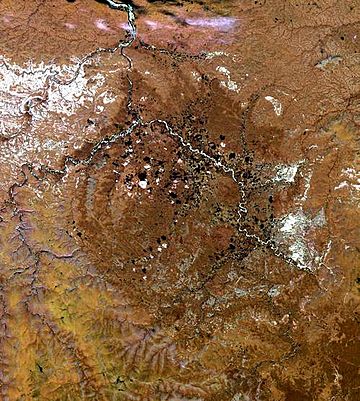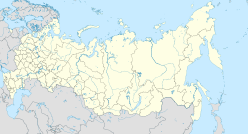Popigai crater facts for kids

Landsat image of Popigai crater
|
|
| Impact crater/structure | |
|---|---|
| Confidence | Confirmed |
| Diameter | 90 km (56 mi) |
| Impactor diameter | 5 ± 2 kilometers (3.1 ± 1.2 mi) |
| Age | 35.7 ± 0.2 Ma Late Eocene |
| Exposed | Yes |
| Drilled | Yes |
| Bolide type | H chondrite |
| Location | |
| Coordinates | 71°39′N 111°11′E / 71.650°N 111.183°E |
| Country | |
| State | Krasnoyarsk |
The Popigai crater is a giant hole in the ground located in Siberia, Russia. It is one of the four largest confirmed impact craters on Earth. About 35 million years ago, a huge space rock (called a bolide) crashed into this spot. This created a crater about 100 kilometers (62 miles) wide. This event happened during a time in Earth's history called the late Eocene epoch. Some scientists think this massive impact might have even played a part in a big extinction event that happened around that time.
The Popigai crater is about 300 kilometers (186 miles) east of a small village called Khatanga. It is also about 880 kilometers (547 miles) northeast of the city of Norilsk. UNESCO has named it a Geopark. This means it is a very special place because of its unique geology. Some scientists think the Popigai impact might have happened at the same time as two other craters, the Chesapeake Bay and Toms Canyon craters, which are also about 35 million years old.
Studying the Popigai Crater
For many years, scientists like paleontologists (who study ancient life) and geologists (who study Earth's rocks) were very interested in the Popigai crater. However, the entire area was difficult to access. This was because of the valuable diamonds found there and the mines that were built.
In 1997, a major scientific trip was finally made to the crater. This trip helped scientists learn a lot more about this mysterious place. They figured out that the space rock that hit Earth was either an 8-kilometer (5-mile) wide chondrite asteroid or a 5-kilometer (3-mile) wide stony asteroid.
Diamonds from the Impact
One of the most amazing things about the Popigai crater is that it's full of diamonds! When the space rock hit, the extreme pressure and heat instantly changed the graphite (a form of carbon) in the ground into diamonds. This happened within a 13.6-kilometer (8.5-mile) area around where the impact happened.
These diamonds are usually quite small, about 0.5 to 2 millimeters (0.02 to 0.08 inches) across. But some special ones can be as large as 10 millimeters (0.4 inches). What's really cool is that these diamonds kept the original shape of the graphite they came from. They even kept the tiny lines, called striations, that were on the original graphite crystals.
Images for kids
See also
 In Spanish: Cráter Popigai para niños
In Spanish: Cráter Popigai para niños




